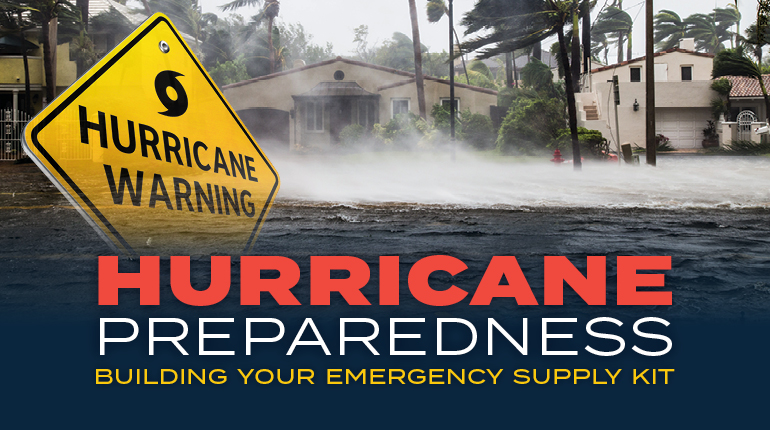
The Atlantic hurricane season runs from June 1 to November 30. If you have lived in the Hampton Roads or Northeast North Carolina over the past few years, you’ve experienced hurricane season. Being prepared now can help you and your family survive on your own for a few days. A disaster supplies kit is a collection of basic items your household may need in the event of an emergency.
- Water – One gallon per person, per day (for drinking and sanitation)
- Food -Non-perishable, easy-to-prepare goods
- Battery-powered or hand-crank radio and an NOAA Weather Radio with tone alert
- Flashlight
- Extra batteries
- Medications (7-day supply)
- Whistle (to signal for help)
- First aid kit
- Family & emergency contact information
- Sanitation/personal hygiene items (including moist towelettes, garbage bags & plastic ties)
- Wrench or pliers (to turn off utilities) and a multi-purpose tool (Swiss Army knife)
- Manual can opener for food
- Cell phone with charger and a backup battery
- Copies of personal documents:
- Medical Information
- Proof of Address
- Deed/Lease to Home
- Identification (Birth Certificates/passports)
- Insurance policies, etc.
- Cash (ATMs & card readers might be inoperable)
- Plastic sheeting & duct tape to shelter-in-place
- Extra fuel for generator and car
- Local maps
* 3-day supply for an evacuation / 2-week supply for home
Additional supplies to consider adding based on your needs:
- Non-prescription medications (pain relievers, anti-diarrheal, antacids, etc.)
- Complete change of clothing and sturdy shoes
- Prescription eyeglasses and contact lens solutions
- Sleeping bag or warm blanket for each person
- Infant formula, bottles, diapers, wipes, and diaper rash cream
- Mess kits, paper cups, plates, paper towels, and plastic utensils
- Food & water for your pet(s)
- Books, games, puzzles, or other activities for children
- Matches in a waterproof container
- Paper and pencil
To assemble your kit, store items in airtight plastic bags and put your entire disaster supplies kit in one or two easy-to-carry containers such as plastic bins or a duffel bag.
Sources | www.fema.gov • www.ready.gov
